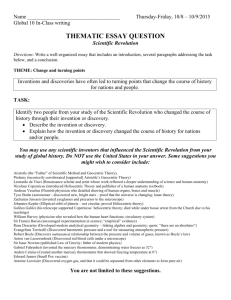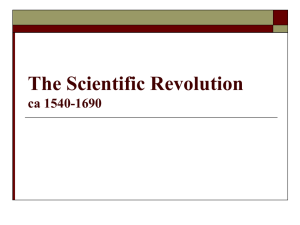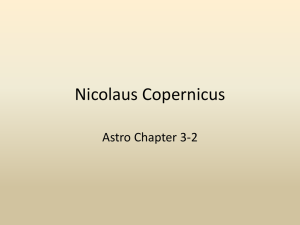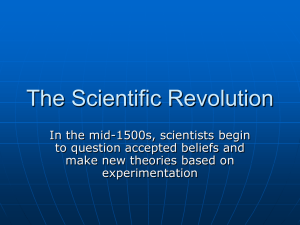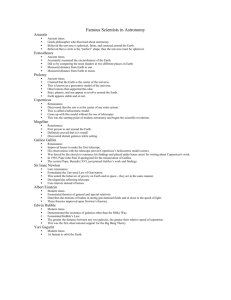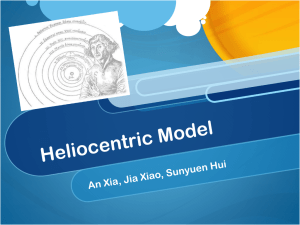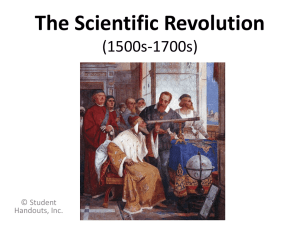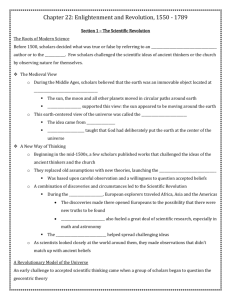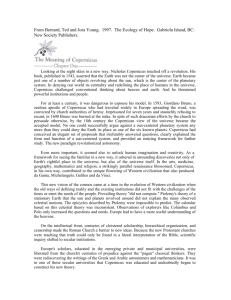The Scientific Revolution
advertisement
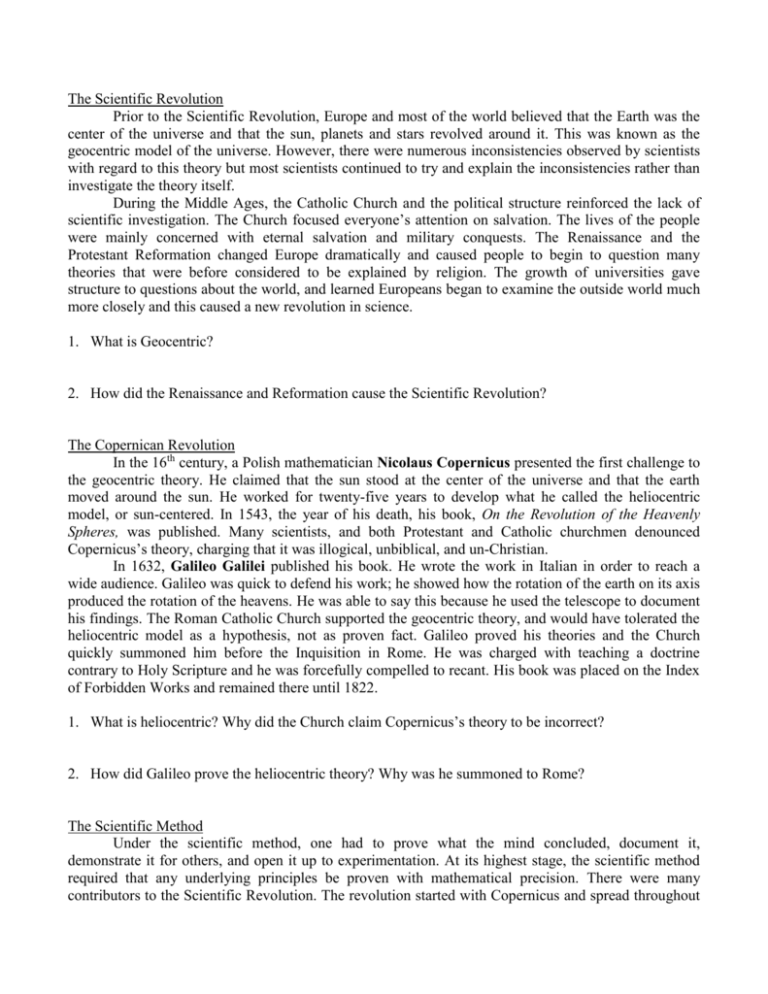
The Scientific Revolution Prior to the Scientific Revolution, Europe and most of the world believed that the Earth was the center of the universe and that the sun, planets and stars revolved around it. This was known as the geocentric model of the universe. However, there were numerous inconsistencies observed by scientists with regard to this theory but most scientists continued to try and explain the inconsistencies rather than investigate the theory itself. During the Middle Ages, the Catholic Church and the political structure reinforced the lack of scientific investigation. The Church focused everyone’s attention on salvation. The lives of the people were mainly concerned with eternal salvation and military conquests. The Renaissance and the Protestant Reformation changed Europe dramatically and caused people to begin to question many theories that were before considered to be explained by religion. The growth of universities gave structure to questions about the world, and learned Europeans began to examine the outside world much more closely and this caused a new revolution in science. 1. What is Geocentric? 2. How did the Renaissance and Reformation cause the Scientific Revolution? The Copernican Revolution In the 16th century, a Polish mathematician Nicolaus Copernicus presented the first challenge to the geocentric theory. He claimed that the sun stood at the center of the universe and that the earth moved around the sun. He worked for twenty-five years to develop what he called the heliocentric model, or sun-centered. In 1543, the year of his death, his book, On the Revolution of the Heavenly Spheres, was published. Many scientists, and both Protestant and Catholic churchmen denounced Copernicus’s theory, charging that it was illogical, unbiblical, and un-Christian. In 1632, Galileo Galilei published his book. He wrote the work in Italian in order to reach a wide audience. Galileo was quick to defend his work; he showed how the rotation of the earth on its axis produced the rotation of the heavens. He was able to say this because he used the telescope to document his findings. The Roman Catholic Church supported the geocentric theory, and would have tolerated the heliocentric model as a hypothesis, not as proven fact. Galileo proved his theories and the Church quickly summoned him before the Inquisition in Rome. He was charged with teaching a doctrine contrary to Holy Scripture and he was forcefully compelled to recant. His book was placed on the Index of Forbidden Works and remained there until 1822. 1. What is heliocentric? Why did the Church claim Copernicus’s theory to be incorrect? 2. How did Galileo prove the heliocentric theory? Why was he summoned to Rome? The Scientific Method Under the scientific method, one had to prove what the mind concluded, document it, demonstrate it for others, and open it up to experimentation. At its highest stage, the scientific method required that any underlying principles be proven with mathematical precision. There were many contributors to the Scientific Revolution. The revolution started with Copernicus and spread throughout Europe. Tycho Brahe built Europe’s most modern astronomical laboratory where he and his associates collected data about the planets and the stars. Francis Bacon published works on inductive logic. This method involved experimentation, and the systematic collection and analysis of data. Johannes Kepler developed the three laws of planetary motion. His main point was that the earth and the other planets revolve around the sun in elliptical orbits. He used mathematics and observation to develop these laws. Rene Descartes promoted the deductive method, whatever could be doubted must be rejected. He resolves to trust only that which is clearly and distinctly seen to be beyond any doubt. In this manner, Descartes peels away the layers of beliefs and opinions that clouded his view of the truth. He began doubting all authorities and all knowledge, both scientific and religious, until he was left with one thing he could not doubt: his own existence, “I think, therefore I am.” Isaac Newton invented calculus to prove the theories of Copernicus, Galileo, Bacon and others. He also developed the law of universal gravitation in his work Principia Mathematica in 1687. All these men and others developed a widely used system of observation, reason, experiment, and mathematical proof that could be applied to every conceivable scientific inquiry. With precise scientific instruments, like the microscope and the telescope, a scientist could retest many theories and prove them as fact. 1. What is the scientific method? 2. Why are these men important? Other Improvements of the Scientific Revolution Zacharias Jansen invented the first microscope. Evangelista Torricelli developed the first mercury barometer. This tool was developed to measure atmospheric pressure and predicting weather. Gabriel Fahrenheit developed the first thermometer to use mercury in glass. His studies showed water freezing at 32 degrees. Anders Celsius developed another thermometer using a different scale. His studies showed water freezing at 0 degrees. There were also many medical improvements. Andreas Vesalius studied human anatomy and published a book that detailed the insides of the human body including organs, bones and muscles. William Harvey also studied anatomy where he showed that the heart acted like the pump to circulate the blood. Edward Jenner introduced the first vaccine to prevent smallpox. Robert Boyle considered modern father of chemistry, challenged Aristotle’s ideas. Boyle said that matter was made up of smaller primary particles that joined together in different ways. Boyle’s law, how the volume, temperature, and pressure of gas affect each other. Deism was also another important discovery of the time. The deists believed in a powerful god who created and presided over an orderly realm but who did not interfere in its workings. The deists believed that God was a watchmaker, one who set up the world, gave it natural laws by which to operate, and then let it run itself (under natural laws that could be proved mathematically). 1. What were some important new inventions and medical improvements of the time? 2. What is deism? Copernicus: On the Revolutions of the Heavenly Spheres Copernicus began a revolution in astronomy when he argued that the sun and not the earth was the center of the universe. Expecting controversy and scorn, Copernicus hesitated to publish the work in which he put forth his heliocentric theory. He finally relented, however, and managed to see a copy of it before he died. “For a long time, then, I reflected on this confusion in the astronomical traditions concerning the derivation of the motion of the universe’s spheres. I began to be annoyed that the movements of the world machine, created for our sake by the best and most systematic Artisan of all [God], were not understood with greater certainty by the philosophers, who otherwise examined so precisely the most insignificant trifles of this world. For this reason I undertook the task of rereading the works of all the philosophers which I could obtain to learn whether anyone had ever proposed other motions of the universe’s spheres than those expounded by the teachers of astronomy at the schools. And in fact first I found Cicero; he supposed the earth to move. Later I also discovered in Plutarch that certain others were of this opinion. I have decided to set his words down here, so they may be available to everyone: ‘Some think the earth remains at rest. But Philolaus the Pythagorean believes that, like the sun and moon, it revolves around the fire in an oblique circle. Heraclides of Pontus and Ecphantus the Pythagorean make the earth move, not in a progressive motion, but like a wheel in rotations from west to east about its own center.’ Therefore, having obtained the opportunity from these sources, I too began to consider the mobility of the earth. And even though the idea seemed absurd, nevertheless I knew that others before me had been granted the freedom to imagine and circles whatever for the purpose of explaining the heavenly phenomena. Hence I thought that I too would be readily permitted to ascertain whether explanations sounder than those of my predecessors could be found for the revolution of the celestial spheres on the assumption of some motion of the earth. Having thus assumed the motions which I ascribe to the earth later on in volume, by long and intense study I finally found that if the motions of the other planets are correlated with the orbiting of the earth, and are computed for the revolutions of each planet, not only do their phenomena follow therefrom but also the order and the size of all the planets and spheres, and heaven itself is linked together that in no portion of it can anything be shifted without disrupting the remaining parts and the universe as a whole… Hence I feel no shame in asserting that this whole region engirdled by the moon, and the center of the earth, traverse this grand circle mid the rest of the planets in its annual revolution around the sun. Near the sun is the center of the universe. Moreover, since the sun remains stationary, whatever appears as a motion of the sun is really due rather to the movement of the earth.” 1. How does Copernicus prove his theory of the heliocentric model? 2. What is Copernicus’s conclusion? 3. What kind of reaction did Copernicus’s theory receive?


